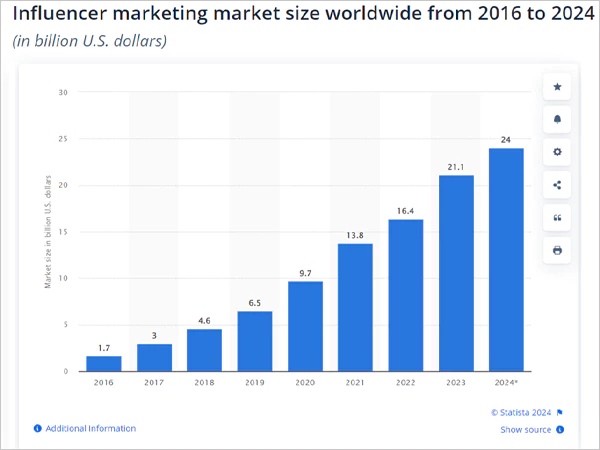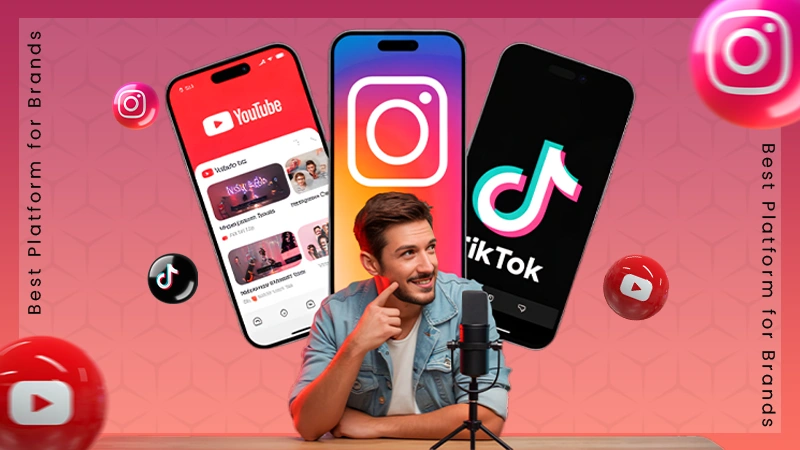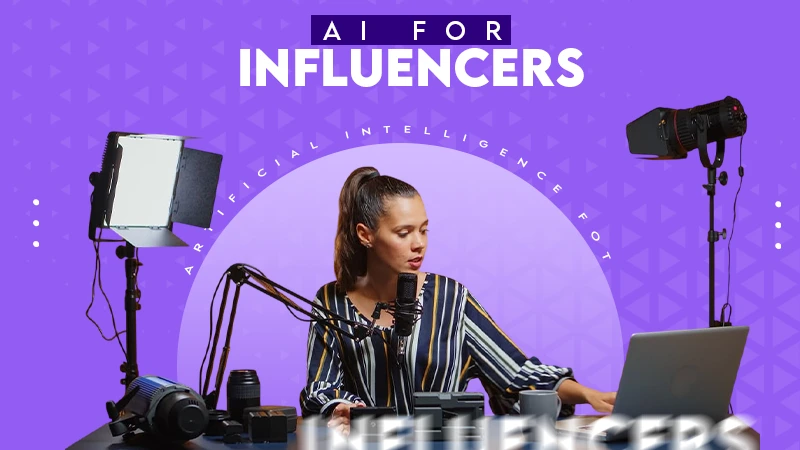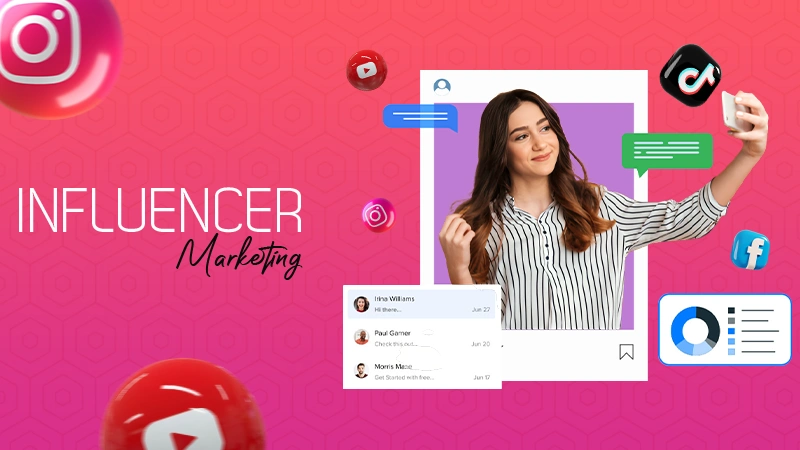Influencers are those people who have a large following on social media. They often work with brands to promote products or services to their followers. Using their online presence, they collaborate with brands and create content to advertise their products and services to their audience.
Know About 13 Different Types of Influencers to Elevate Your Marketing Campaigns
If you’re a brand looking to expand your reach or a marketer aiming to connect with a specific audience, knowing the different types of influencers is essential for a successful marketing strategy.
Finding the right influencer can make all the difference in achieving your intended goals.
So, this blog explains the different types of influencers based on their follower count and industry niche to help you determine which ones fit best with your brand’s objectives.
Not only that, but by the end, you’ll also know how to choose the right influencer, where you can find them easily, and how you can distinguish between fake ones.
That being said, let’s dive into the details—
Understanding Influencers: Who Is an Influencer?
An influencer is someone who creates various types of content, such as videos and blog posts, that resonate with their followers.
They generally express their thoughts, opinions, and views on different topics, which their audience finds influential.
Additionally, they endorse or recommend products or services that significantly impact their followers’ purchasing decisions.
Influencers have a ‘dedicated online following’, basically a group of people who regularly follow and engage with their content within a specific niche, such as fashion, technology, beauty, or fitness.
In short, influencers are powerful figures on social media platforms who use their trustworthiness and popularity to influence their followers’ actions and preferences.
They leverage their credibility to shape the behaviors and trends within their audience. By doing so, they play a crucial role in modern marketing strategies that lead to increased brand awareness and sales.
What is Influencer Marketing: An Introduction!
Influencer marketing is a modern advertising approach.
It is a form of social media marketing where brands collaborate with influencers (individuals who have a significant following and influence) on social media platforms.
By partnering with influencers, brands can take advantage of their popularity and trust to reach potential customers more authentically and engagingly than traditional advertising methods.
Influencer marketing involves creating content that features or promotes the brand’s products or services to their followers. It involves—
- Sponsored Posts: Influencers mention or highlight a brand or product in their posts by clearly saying it’s sponsored.
- Product/Service Reviews: Influencers share their experiences and opinions about a product or service they’ve used.
- Social Media Takeovers: Influencers manage a brand’s social media account on a temporary basis, by creating and sharing content directly on it.
- Brand Representatives: Influencers create multiple pieces of content for a brand to represent it over a long period of time.
Overall, influencer marketing helps brands increase their visibility, connect with target audiences, and drive sales by leveraging the credibility and influence of trusted and popular social media influencers.
Fact Check:
As per Statista, the value of the global influencer marketing market in 2023 was worth 21.1 billion U.S. dollars. It is more than 3 times its value in 2019.
This rapid growth shows that influencer marketing is becoming an increasingly popular and important facet of the digital marketing world. So, this is why we’re witnessing more and more collaboration between brands and influencers today!

4 Different Types of Influencers By Followers Count
If you’re a brand considering influencer marketing for your campaign or promotion, you need to be aware that there are different types of influencers.
When you’re familiar with the various types of influencers available, you’ll be able to determine which one is best suited to help you achieve your desired goals.
So, here are the 4 different types of influencers by their follower count—
Nano Influencers
Nano Influencers have a small yet highly engaged audience. They often have strong relationships with their followers and high levels of trust and authenticity.
Their content tends to feel more personal and relatable. So, brands can collaborate with nano influencers to reach specific, niche audiences and benefit from high engagement rates and targeted marketing.
- Reach: 1000 (1K) – 10,000 (10K) Followers
- Examples: @jamesthomas110, @marc.wanderlust, and @wellness_with_jess, etc.
- Best For: Local (small to mid-sized) businesses, niche markets, and brands looking to build authentic connections with a limited budget.
Micro Influencers
Micro-influencers have a larger (highly engaged) audience than nano-influencers, but they still maintain a close relationship with their followers. They often focus on specific niches or industries and offer a good balance between reach and engagement. So, it wouldn’t be wrong to say that they can provide brands more visibility while maintaining a relatively high level of trust and authenticity among the audiences.
- Reach: 10,000 (10K) – 100,000 (100K) Followers
- Examples: @plantmom.amsterdam, @lola_jagger, @laurencaruso_, @lesleymarie1213 and @mamaswahnsinn etc.
- Best For: Brands who’re looking to target specific niches with a moderate budget.
Macro Influencers
Macro influencers include established bloggers, YouTubers, and social media personalities. They have a significant following and are well-known within their industry, or you can say at a broader level. So, their endorsement can reach a larger audience and provide great visibility for brands.
- Reach: 100,000 (100K) – 1 Million Followers
- Examples: @adamgonon, @ariannahuff and, @neilpatel etc.
- Best For: Big companies with larger budgets who aim for widespread brand recognition and a broader reach.
Mega Influencers
Mega influencers are typically A-list celebrities or public figures with a massive following of over 1 million. Needless to say, they have a wide-reaching impact on the audience and are often recognized globally. In other words, they have extensive reach and can influence public opinion on a large scale. Their endorsements can drive massive awareness and generate significant buzz for the brands they collaborated with.
- Reach: 1 Million+ Followers
- Examples: @kyliejenner, @cristiano, @selenagomez, @piwdiepie and, @chiaraferragni, etc.
- Best For: Major brands who have a hefty marketing budget and want to maximize their visibility and reach a vast, diverse audience.
Each of these 4 types of influencers brings their unique strengths and advantages to the table. So, choosing who to work with depends on the brand’s goals, target audience, and budget.
9 Different Category of Influencers By Industry or Niche
By now, you should have understood the 4 different types of influencers, but that’s not it! Besides the follower count, influencers are also categorized by their industry or niche.
When selecting an influencer to promote your brand, it’s not enough to just look at how many followers they have. You also need to find an influencer who specializes in the niche or industry that is relevant to your brand, right?
So, these are the other 9 different Influencer categories that you’ll find on Instagram, YouTube, Facebook, and other popular platforms based on industry or niche—
Fashion And Beauty Influencers
These influencers set trends and inspire their followers with styling tips, product reviews, and tutorials.
Sub Niche:
- Skincare routines
- Makeup tutorials
- Budget friendly beauty product reviews
- Fashion styling for different body types
- Hair Care tips and tutorials
- Nail art
- DIY beauty, etc.
This category of influencer is crucial for brands who are looking to market cosmetics, clothing, accessories, etc.
Health And Wellness Influencers
These influencers focus on promoting healthy lifestyles, fitness routines, and wellness products.
Sub Niche:
- Yoga and meditation
- Healthy recipes
- Meal plans
- Mental health awareness
- Fitness challenges
- Workout routines
- Supplements
- Wellness practices
- Weight loss journey and tips, etc.
Hence, they are considered ideal for brands that work in the health, fitness, and nutrition sectors.
Travel And Adventure Influencers
This category of influencers is often seen as sharing their journeys, travel tips, and hacks.
Sub Niche:
- Luxury travel experiences
- Budget-friendly travel hacks and tips
- Solo travel adventures
- Family travel
- Adventure sports and activities
- Eco-friendly travel initiatives
- Culture, heritage, and local experiences
- Outdoor adventure, etc.
So, brands in the travel, hospitality, and outdoor-gear industries can benefit from travel and adventure influencers’ vibrant content they share among wanderlust enthusiasts.
Food And Nutrition Influencers
These influencers share recipes, cooking tips, and nutritional advice among their followers.
Sub Niche:
- Food photography
- Food presentation
- Meal prep and planning guides
- Vegan recipes
- Keto diet
- Plant-based diet
- Food science and nutrition education, etc.
So, they are perfect for brands in the food and beverage industry who are looking to engage with food lovers and health-conscious consumers.
Technology And Gaming Influencers
These influencers’ role is to review the latest gadgets, software, and games. Their reviews and insights significantly influence industry trends and consumers’ buying decisions.
Sub Niche:
- Video game walkthroughs
- Tech product unboxing and reviews
- Gaming hardware and software tips
- Streaming coverage
- Troubleshooting guides
- Coding and programming tutorials, etc.
So, tech and gaming industry brands collaborate with these influencers to reach their target (tech-savvy) audiences.
Sports And Fitness Influencers
These influencers motivate their followers with their workout routines, and sports tips, and connect with them by giving fitness challenges.
Sub Niche:
- Sports training and techniques
- Athlete interviews
- Game reviews
- Fitness challenge and transformation
- Sports gear reviews
- Team matchups
- Tips for injury recovery
- Game types
- Sports nutrition and advice on supplements, etc.
This category of influencers is best for brands related to sportswear, equipment, and health supplements. To target fitness enthusiasts, these brands can collaborate with sports and fitness influencers.
Lifestyle Influencers
Lifestyle influencers cover a wide range of topics, including fashion, travel, home decor and personal development as well.
Sub Niche:
- Home decor and interior design inspiration
- Strategies for time management
- Tips for increasing productivity
- Hobby and DIY project ideas
- Decluttering tips
- Personal development and self-improvement advice, etc.
So, lifestyle influencers are ideal for brands who want to reach a broad audience interested in various aspects of everyday life.
Business And Finance Influencers
These influencers provide insights on entrepreneurship, investing, and financial planning to their audiences.
Sub Niche:
- Entrepreneurship tips
- Success stories
- Stock market analysis
- Investment strategies
- Career development and job market analysis
- Income streams
- Business book reviews and recommendations
- Personal finance management and budgeting, etc.
They are the most suitable option for brands in finance, banking, and business services who are looking to attract professionals and aspiring entrepreneurs.
Parenting And Family Influencers
Last but not least, this category of influencers includes those who share parenting tips, family activities, and product recommendations for children.
Sub Niche:
- Homeschooling tips and advice
- Parenting hacks
- Showcasing life with kids
- Products reviews for families and children
- Child development milestones
- Working mom
- Parenting twins
- New mom
- Kids activities
- Family-friendly snack recipes and meal ideas, etc.
So, brands who deal in baby products, toys and family services can find these influencers valuable assets for reaching families and parents.
How to Choose the Right Type of Influencer for Your Marketing Brand or Campaign?
If you’re still confused about choosing the right type of influencer for your marketing brand or campaign, consider these suggestions—
- Start by defining your marketing goals and target audience. You need to understand what you want to achieve with your marketing campaign and who your ideal customers should be.
- Then, take into account the influencer’s niche. Basically, look for influencers whose content matches your brand’s industry or niche so that your products or services interest their audience.
- Next, you must evaluate the engagement rate and authenticity of the influencer. This is important to understand how actively their audience interacts with them and whether they genuinely believe in the products they promote.
- Other than this, you can assess their compatibility with your brand values to maintain credibility in your marketing efforts.
- In addition to that, you must also review the quality of their content. The higher the quality of the content, the more it is likely to resonate with your target audience.
So, you should collaborate with influencers whose followers match your target audience, who’ve a strong connection with followers, and whose following genuinely believe in the product they promote.
Pro Tip: You can also use tools and platforms like HypeAuditor to analyze the influencer’s metrics such as followers demographics, reach, and engagement – to make informed decisions based on this data.
Where All You Can Find the Best Influencers for Your Marketing Brand or Campaign?
Social media platforms, including Instagram, YouTube, TikTok, and Facebook are widely used for finding the best influencers for marketing brand or campaign.
On these platforms, you can search for relevant influencers by using hashtags related to your industry or campaign. Additionally, you can also monitor trending topics and content that lead you to influencers who resonate well with your target audience.
Another good option is to utilize specialized tools like AspireIQ, Upfluence, and Traackr etc. They provide a database of influencers along with analytics (such as influencer’s reach, engagement rate, and audience demographics) to help you identify the best ones for your needs.
Other than this, attending events related to your industry or niche can be a good way to meet influencers in person. And, why not, when it is true that building face-to-face relationships can sometimes lead to more authentic partnerships?
Lastly, you can also reach out to PR agencies, as they often have established connections with influencers across different platforms. So, you never know, they might ease your task of finding the right influencer for your brand or campaign.
How Can You Recognize and Beware of Fake Influencers?
In order to identify fake influencers and avoid them, it’s essential that you focus on their engagement rates, follower growth, and content quality.
Real influencers have active engagement with their followers. So, look at their likes and comments to ensure they align with their follower count. For that, you can use apps like SocialBlade and Hootsuite. Needless to say, low engagement or a sudden spike in likes and comments mean they might be fake.
Also, check if their content matches their ‘claimed’ expertise level. If they post low-quality content or are inconsistent in posting content, then this might be a red flag.
Next, you should look at whether they have collaborations with trustworthy brands. If not, maybe they are not the ones you should be collaborating with!
Moreover, you can also research their background to confirm their credibility.
Overall, being cautious and informed, helps you avoid getting misled by fake influencers and protect your brand value and investments.
Wrapping Up!
That’s all! These days, social media has become a powerful tool for marketing due to its extensive user base. Hence, using influencers is a strategic approach for brands to reach their potential customers. But, since there are different types of influencers, brands should choose the one that fits best with their campaign goals.
So, basically, with the right influencer, you can increase your brand’s reach, enhance engagement, and drive sales. However, remember to choose influencers who align with your brand’s values and target audience. And, most importantly, stay vigilant against fake influencers.
Who is called an influencer?
What are the main four types of social media influencers?
The main four types of social media influencers are—
- Nano Influencers
- Micro Influencers
- Macro Influencers
- Mega Influencers
Which type of influencer is the most popular?
Generally, micro and macro influencers are often considered popular due to their potential to maintain an authentic connection with their audience/followers while still enjoying a sizable audience.
What is the average follower count of different types of influencers?
The average follower count varies across different types of influencers. For instance— Nano influencers have between 1,000 and 10,000 followers. Micro-influencers have 10,000 to 100,000 followers, Macro influencers have 100,000 to 1 million followers; and Mega-influencers have over 1 million followers.
What qualifies a person as an influencer?
A person is considered an influencer when they have a substantial following on social media. Along with that, power to influence other people’s opinions, choices, or actions, like what to buy and what to believe. This power comes from their expertise and popularity within a specific niche, such as fashion, travel, fitness, beauty, or, technology, etc.
What are the different levels of influencers, and how do they vary in terms of their follower counts?
The different levels of influencers are defined by their follower count. It’s their followers count that differentiates them from each other and classifies them into these 4 different categories—
- 1K–10K Followers – Nano Influencers
- 10K–100K Followers – Micro-Influencers
- 100K–1M Followers – Macro Influencers
- 1M+ Followers – Mega Influencers







